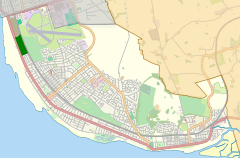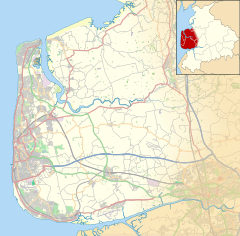Lytham Pier facts for kids

Lytham Pier, c. 1920
|
|
| Type | Pleasure |
|---|---|
| Carries | Pedestrians |
| Locale | Lytham |
| Design | Eugenius Birch |
| Construction | Robert Laidlaw |
| Total length | 914 feet (279 m) |
| Opening date | 17 April 1865 |
| Destruction date | 4 March 1960 |
| Coordinates | 53°44′01″N 2°57′45″W / 53.7337°N 2.9626°W |
Lytham Pier, a pleasure and working pier, was opened in the seaside town of Lytham, Lancashire, England in 1865, in the face of reservations from local residents. The pier underwent several renovations during the 1890s and early 1900s before being badly damaged by a storm in 1903, during which two barges collided with the structure and split it in two. A fire in 1928 resulted in extensive damage to the pavilion, which was not rebuilt, although the pier itself was reopened several months later. Following a period of decline it was closed to the public shortly before the outbreak of the Second World War. The pier was demolished in 1960 despite the protests of thousands of local residents.
Plans to rebuild the pier were discussed by local councillors in 2007, with the Lytham St Annes Civic Society opposed to any such plan and no further progress has been made since that initial proposal.
History
Planning
Provision for a pier to be constructed for pleasure and as a boat-landing deck was first discussed during the early 1860s, leading to the formation of the Lytham Pier Company in 1861. Plans included visitor waiting rooms at the pier head and ornamental gates at the entrance, similar to those at Brighton's West Pier. Its construction began in 1864 with the screwing in of the first iron pile, a pre-planned event designed to ensure a suitably large number of visitors would be present to witness the occasion. The pier did not have unanimous local support; some residents believed that Lytham had insufficient regular visitors to make a pier financially viable, or that a high tide would too easily destroy the pier.
Construction
Despite some reservations, building work was completed a year after the first pile had been screwed in, at a cost of £5890 (equivalent to £589,000 in 2019). The pier was opened by Lady Eleanor Clifton on Easter Monday, 17 April 1865.
three hundred long tons (305 t) of iron were used in the construction of the pier. It was supported by 126 iron columns, 54 feet (16 m) apart and screwed into the solid clay base beneath the beach. A shelter was erected on the pier head's dock for passengers embarking or landing from steam vessels. The pier was capable of accommodating up to 5000 people, of whom 1000 could be seated.
Operation
The pier had a small renovation in 1892 when a floral hall pavilion was added half-way along the deck, at a cost of £12,000 (equivalent to £1.3 million in 2019 ). A further reconstruction followed in 1901–1902 to enlarge the pavilion, including raising the roof to accommodate taller stage scenery and enlargement of the theatre stage; other improvements included the erection of an additional dressing room, refreshment rooms and an upper tea-room added to the pavilion's balcony.
The pier suffered significant damage from two separate incidents in 1903. The first occurred on 27 February, when two shelters were blown into the sea during a storm. Worse damage was caused later in the year on 6 October, when two barges driven by a gale-force wind collided with the pier despite the best efforts of the one-man crews on each boat; one caused significant damage to the central pier structure while the other got caught among the piers supporting the pavilion. Claims for compensation were made against Preston Corporation, who owned the barges, and after repairs had been undertaken the pier reopened at Easter 1904.
During the early 1900s, George Kingston's Minstrels became an attraction on the pier and the beach, continuing through to 1910 on the pier and in the pavilion. Divers performed each season at the pier head in swimming displays, featuring Professor Stearne and Professor Payne. A Floral Hall opened in July 1911, occasionally playing host to orchestral concerts, as well as amateur dramatic societies. By the 1920s, the pavilion was showing films and this was its primary fare income from visitors.
Decline
By 1920 the pier was struggling to remain financially viable; JH Harrison, the manager of 32 years, stepped down the following year. The pavilion was destroyed by fire on 29 January 1928, which left behind a steelwork shell that was not rebuilt. The cause of the blaze remains unknown. The cost of the damage, covered by insurance, amounted to thousands of pounds, but there were no fatalities, as the on-site caretaker who lived on the pier had only just left his residence to sound the alarm before it was engulfed by the flames. Despite a proposal several months later to build a new pavilion at the pier's shore end, from a design prepared by St Anne's architect Arnold England, no work was carried out and the pier reopened on 24 May 1928 without a pavilion.
The next ten years saw a plan by then owners Lytham Pier & Amusements Ltd to convert the pier into the shape of a ship, but it came to nothing. As its popularity dwindled, the pier closed to visitors in 1938 and it subsequently deteriorated throughout the mid-20th century, remaining in use by anglers only. The kiosks at the pier's entrance remained in use, but the council decided in 1959 that they were unwilling to provide the £5000 (equivalent to £108,000 in 2019 ) then required for the pier's restoration. It was subsequently demolished in March 1960 at a cost of £7320 (equivalent to £156,000 in 2019 ) including £4000 (equivalent to £66,000 in 2021) in compensation to then owner Harry Kaniya, despite a petition opposed to the plan from local residents, which gathered almost 2600 signatures.
Reconstruction proposals
It was reported in May 2007 that local Conservative councillors were investigating the possibility of securing a grant to reconstruct the pier. Councillor Richard Fulford-Brown believes that if the circumstances regarding the pier's demolition were an issue today, it would be considerably more difficult to follow through with it and takes the view that a pier visitor attraction offers something interesting for residents and visitors alike. A similar suggestion had previously been made by a local architect, who proposed an eco-friendly boardwalk complete with a viewing station. As of 2007, Lytham St Annes Civic Society were opposed to any reconstruction proposal on the grounds that the town centre should be protected, especially as there are already piers in nearby Lytham St Annes (St Anne's Pier) and Blackpool (North Pier, Central Pier and South Pier) respectively.





